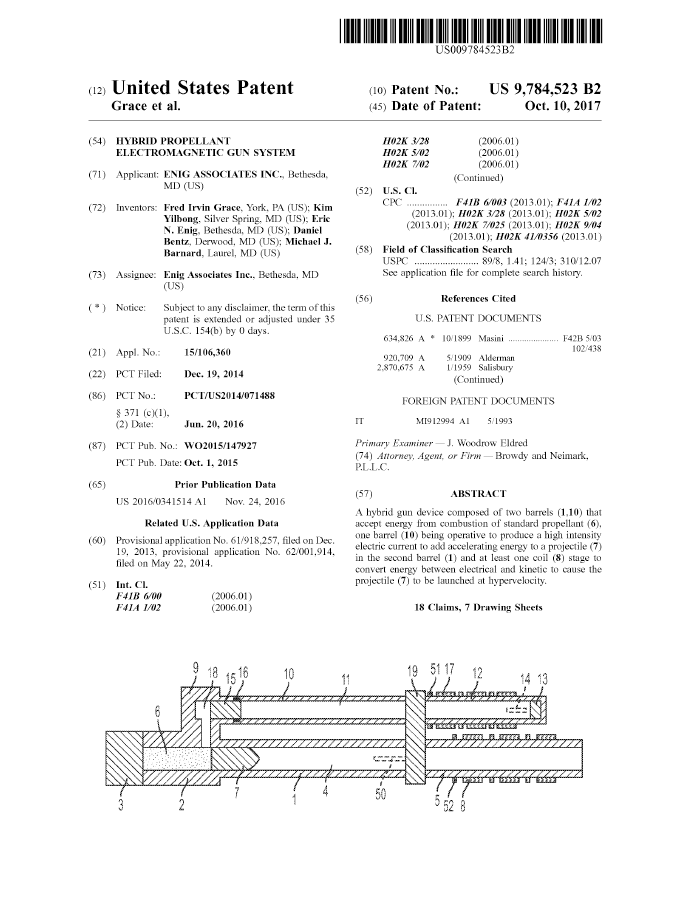ENIGWIRE
 What is Driving the Need for Higher Projectile Velocity by the DoD?
What is Driving the Need for Higher Projectile Velocity by the DoD?
There is a renewed interest by the DoD to develop small-to-large caliber gun platforms with the ability to propel projectiles to much higher velocity than current state-of-the-art allows. With no less complexity, the warfighter seeks projectiles which can (i) travel greater distances, (ii) have reduced time of flight so that maneuvering targets can be engaged with higher hit probability, and (iii) provide greater lethal effects on engaged and/or impacted targets. All are challenging problems.
“Projectile launch, using conventional propellants, is generally limited to 1700 m/s, even for smaller mass, since the acceleration process is limited by the sound speed of the propellant gases,” noted ENIG President, Eric N. Enig. In practical cases, about 1700 m/s is used for tank guns firing long rod projectiles. On the other hand, systems that use electromagnetic acceleration techniques are not limited by this factor. Such systems include electromagnetic rail guns and coilguns. There are various advantages and disadvantages associated with rail gun technology. In the case of the latter, rail gun launch includes (i) excessive wear on the electrically-conducting rails and (ii) a need for large capacitor banks or rotating machinery as power sources. Factors, such as rail wear and excessive heat, can require that rails be replaced with some frequency. “To overcome or negate the degrading effects of friction, within the system, and remove the huge power supply requirements experienced by the rail gun community, ENIG has developed new hybrid coilgun technologies using standard propellants as the energy source, converting a portion of that energy into electromagnetic energy to be used as the final stage of a frictionless projectile acceleration,” said Enig.
How does HyGUN-2TM Address that Need?
High velocity is obtained by accelerating a projectile in two phases, using the hybrid approach of the invention; the first phase uses propellants and a second phase uses electromagnetic energy. HyGUN-2TM uses propellant to generate electrical energy in a separate auxiliary barrel acting as an electrical generator and applies that energy to further accelerate the projectile already in motion in the main barrel. Prior propellant gun state-of-the-art technology alone cannot accelerate projectiles to hypervelocity. Prior coilgun state-of-the-art technology could, in principal, launch projectiles to hypervelocity but only with undue burdens of large, heavy, and bulky external electrical power supplies. In addition, recharging such electrical storage devices requires additional machinery and undue amounts of time, which can substantially reduce firing rates. “The use of coilgun technology hasn’t worked its way into current weaponry. This is largely due to the logistical nightmares associated with extremely large energy storage systems required to power the gun,” said Enig, who added that in addition to inability to launch projectiles at hypervelocity, conventional guns also produce large flash and blast signatures when fired and therefore give away the gun position and create hazardous conditions for the gun-firing crew.
ENIG’s hybrid electromagnetic gun technology overcomes many of these drawbacks. “HyGUN-2TM uses propellant entirely as the energy source so that large external power supplies are not required. The propellant is applied in similar manner to conventional guns and can be reloaded rapidly to maintain firing rates,” noted Enig. HyGUN-2TM accelerates the projectile in two phases using conventional propellants for the first phase and electromagnetic energy in the second phase. The electromagnetic coil system can be more efficient in the second phase since it acts on a moving projectile produced by conventional propellant in the first phase. By the end of the first phase, the projectile has acquired all of the kinetic energy provided by the propellant combustion and thus combustion product gases are vented at that point in the two-phase acceleration process. HyGUN-2TM’s early venting of propellant gases helps reduces the peak blast pressure, as the projectile exits the muzzle, and therefore is less hazardous to the gun crew. The number of coil stages needed for HyGUN-2TM to accelerate a projectile to a given hypervelocity is greatly reduced as compared with a coilgun producing that same velocity from a projectile initially at rest. “HyGUN-2 uses firing procedures similar to conventional gun technology using propellants, while the electromagnetic aspect can be made transparent or secondary to gun operations. Therefore, development, scalability, etc. of HyGUN-2TM is reasonably straightforward and can be implemented more easily in weapons for the warfighter,” said Enig, who noted that the company is investigating ways of utilizing parasitic electromagnetic energy generated from HyGUN-2TM operation to mitigate or obscure inherent optical and RF signatures at the gun muzzle’s end.
(For more information, contact media@enig.com.)

